Description: This perennial sedge is about 1½–2½' tall. It is often tufted at the base, sending up multiple leafy culms. Infertile shoots are less common and conspicuous than fertile shoots. Each culm is unbranched, slender, and rather stiff. It is light green to green, 3-angled, glabrous, and smooth, except near the inflorescence, where its texture is often rough. Each fertile shoot has about 3 alternate leaves, which are located on the lower one-third of the culm. The individual leaf blades are about 5-10" long and 3 mm. across; they are light green to green, glabrous, longitudinally furrowed, and ascending to spreading. The sheaths are mostly light green, longitudinally veined, and glabrous; they adhere tightly to their culms. However, the apices of the inner sheaths are white-translucent, forming a shallow U-shape.
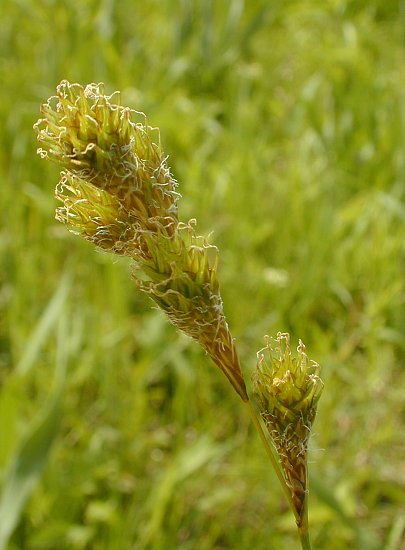
Each culm terminates in a short inflorescence up to 2" long. This inflorescence consists of about 3-6 spikelets that are nearly sessile. The slender rachis (central stalk) of each inflorescence can be straight or nodding; it is light green and glabrous. Each spikelet is up to 15 mm. long and 5-7 mm. across; it is ovoid in shape and either rounded or club-shaped (clavate) at the bottom. Staminate (male) florets, if any, are located at the bottom of each spikelet, while pistillate (female) florets are located at the top. Spikelets with abundant staminate florets tend to be longer and more club-shaped than those with few or no staminate florets. Each spikelet has numerous spreading to ascending perigynia. Each perigynium is about 5-6 mm. long, 3.5-4 mm. across, and glabrous; it is ovoid-flattened, rounded at the bottom, and with a beak at the top. There are usually several fine veins along both sides of the perigynium, and its margins are narrowly winged. Immature perigynia are light green, but they later turn brown.
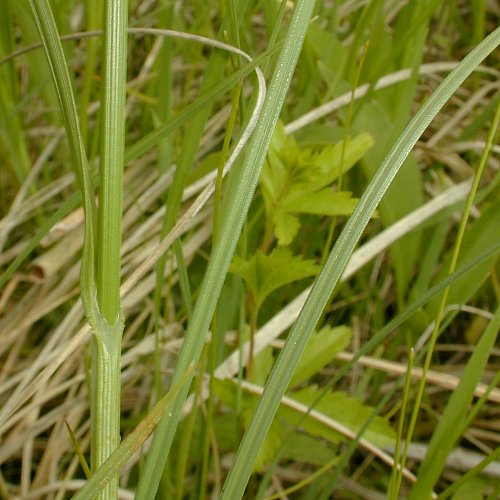
The pistillate scales are about 3 mm. long, 1 mm. across, and lanceolate in shape; they are shorter than the perigynia. The pistillate scales have central green veins and membranous margins; they later become tan or brown. The lowest leafy bract of the inflorescence is about ½" long and narrowly linear in shape; it is sometimes absent. Other bracts are either insignificant or absent. The blooming period occurs during late spring, lasting about 1-2 weeks. The florets are cross-pollinated by the wind. Afterwards, the achenes become mature during the summer within their perigynia; they are distributed to some extent by the wind. Individual achenes are about 2 mm. long and 1.5 mm. across; they are ovoid-flattened in shape. The root system is fibrous and short-rhizomatous.
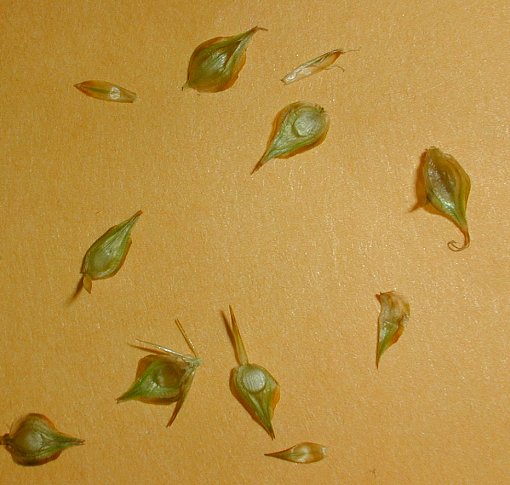
Cultivation:
The
preference is full sun and mesic to dry conditions. Various kinds of
soil are tolerated, including loam and clay-loam. Most growth and
development occur during the spring or early summer. This sedge adapts
to cultivation in a sunny garden, but it resents competition from tall
broad-leaved forbs.
Range & Habitat:
The native Bicknell's Sedge is occasional in central and northern
Illinois, while in the southern section of the state it
is uncommon or absent (see Distribution
Map). Habitats include moist to dry prairies, hill prairies,
cemetery prairies, barren rocky
areas with scant vegetation, thinly wooded slopes, and savannas. This
sedge is usually found in higher quality natural habitats.
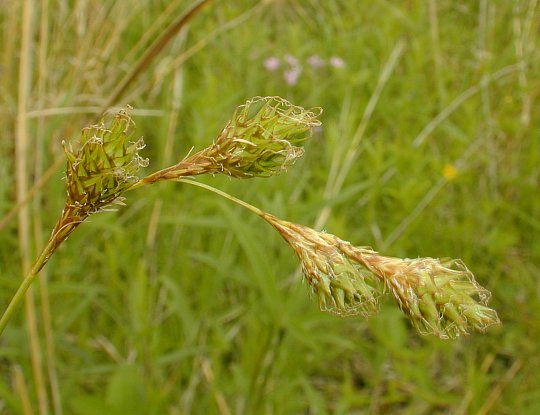
Faunal Associations: Bicknell's Sedge and other sedges (Carex spp.) that occupy open upland areas are host plants to the Red-legged Grasshopper (Melanoplus femurrubrum), Large-headed Grasshopper (Phoetaliotes nebrascensis) and other grasshoppers (see Grasshopper Table). Other insects that feed on such sedges include the Southern Corn Billbug (Sphenophorus callosus) and leaf-mining larvae of the moth Elachista madarella. Among vertebrate animals, some upland gamebirds and granivorous songbirds eat the seeds during the summer, fall, or winter. Examples of such birds include the Ring-Necked Pheasant, Greater Prairie Chicken, Horned Lark, Savannah Sparrow, Henslow's Sparrow, Tree Sparrow, Snow Bunting, Lapland Longspur, and Slate-Colored Junco. While sedges are not preferred as a source of food, they are grazed occasionally by hoofed mammalian herbivores.
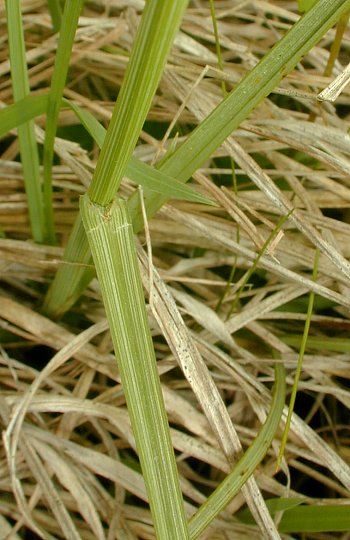
Photographic
Location:
Cemetery prairies near Paxton and Loda, Illinois. The bottoms of the
photographed spikelets have more than the usual number of
staminate florets for this species. As a result, they are club-shaped.
Comments:
This species is sometimes referred to as the 'Prairie Sedge' because of
its preference for this type of habitat. It is in the Ovales Section of
Carex spp. (Sedges), which are usually difficult
to distinguish from each other. However, Bicknell's Sedge has larger
perigynia than other species in this section (up to 6 mm. long
& 4 mm. across).